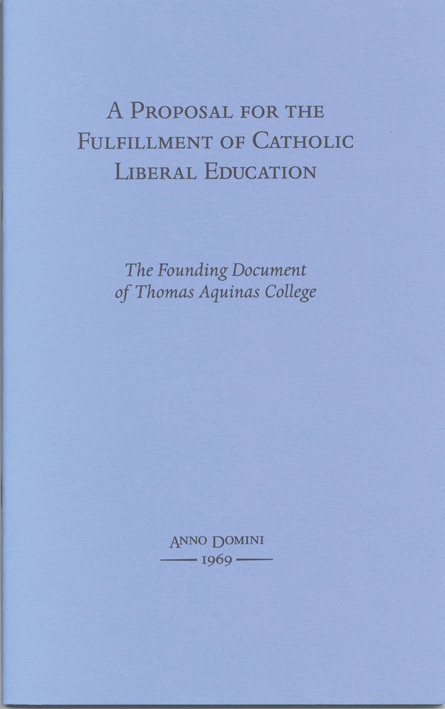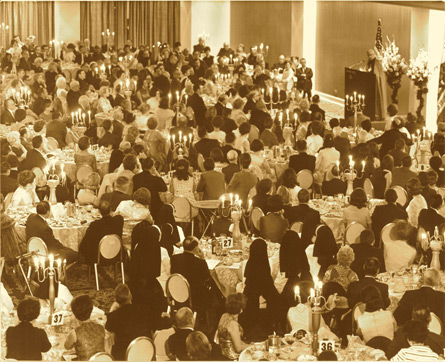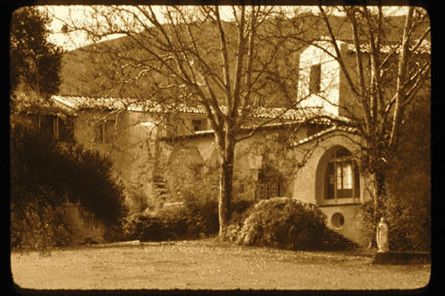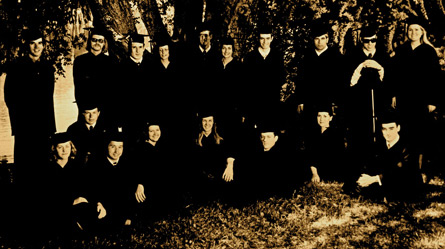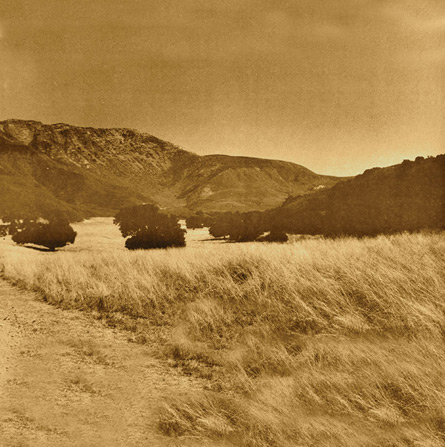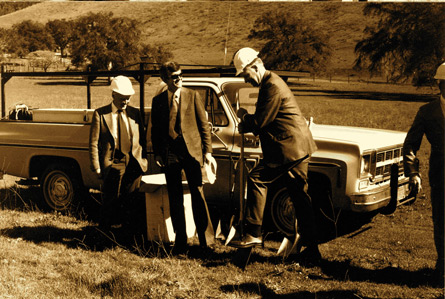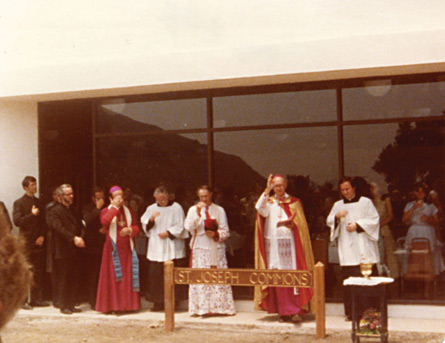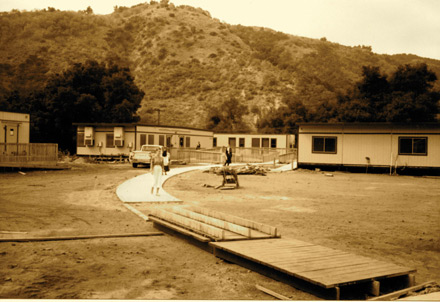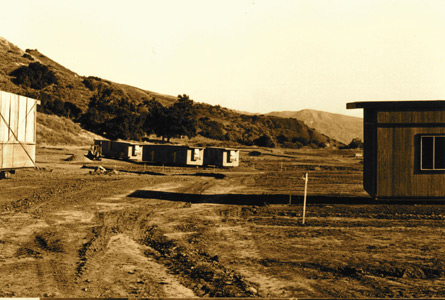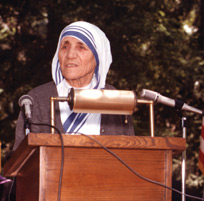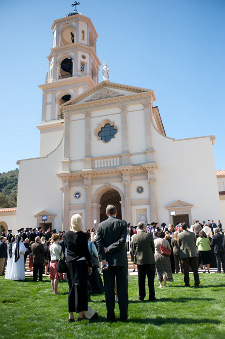“The story of Thomas Aquinas College is one of Divine Providence,” said Founding President Dr. Ronald P. McArthur in 2011. “What this College has become, what it has achieved, in just four decades is far greater than the sum of our human labors. Where our own efforts have failed — where we have erred or simply come up short — He has, again and again, offered His blessings and protection.”
In the 1960s at St. Mary’s College, Moraga, near Oakland, California, five philosophy professors — Dr. McArthur, Dr. John Neumayr, Dr. Frank Ellis, Mr. Marc Berquist, and Br. Edmund Dolan, F.S.C. — observed with great concern the rapid disintegration of Catholic higher education in the United States. Their observations engendered a series of conversations, which culminated in the drafting of A Proposal for the Fulfillment of Catholic Liberal Education, the founding document of Thomas Aquinas College.
The “Blue Book,” as it came to be known for the color of its cover, detailed plans for a new college, one that would operate under the twin beacons of faith and reason, in fidelity to the Magisterium and the teaching Church. At this new school, the curriculum would employ exclusively the great books — the seminal works of the greatest minds of Western civilization. In classes of 15-18, students would learn through the Socratic discussion method. There would be no electives and no majors or minors; all students would study from the same, integrated curriculum ordered to learning the truth about nature, man, and God Himself.
From “The Blue Book” sprang Thomas Aquinas College. From the very beginning, the College would rely on the generosity of many friends and benefactors. Among the first were oil magnate and philanthropist Henry Salvatori, whose initial $10,000 grant funded the College’s incorporation on October 14, 1968. Dr. McArthur was the corporation’s president and chairman, and one of his former students, Mr. Peter DeLuca would serve as the College’s first employee and principal administrator.
On April 25, 1970, the College staged a major promotional dinner at the Fairmont Hotel in San Francisco, attended by 450 people and featuring as the keynote speaker the Most Rev. Fulton J. Sheen. Members of the Board of Governors, especially San Francisco attorney John Schaeffer, played a substantial role in the success of the event.
Although originally the College was to have opened its doors on the campus of Dominican College in the Bay Area, those plans fell through. Fortunately, through the invitation and assistance of James Cardinal McIntyre, Archbishop of Los Angeles, the College was able to lease a campus at Claretville, the former novitiate and seminary of the Claretian order in Malibu Canyon in Southern California. A freshman class was recruited, and on September 11, 1971, 33 students enrolled, with classes commencing three days later. In 1975, the California Department of Education gave the College power to grant degrees, and on June 7 of that year, the College graduated its first class.
Relocation and Transition
For seven years, the College operated and educated students at Claretville, but it needed a permanent campus of its own. In 1975, College officials learned of a property located in a canyon six miles north of the picturesque farming town of Santa Paula, amid the steep mountains of the Los Padres National Forest. The founders thought its beautiful and secluded location would make an ideal setting for the Catholic community of learning they were nurturing. Yet the price of the property — in excess of $2 million — was more than the fledgling school could afford.
Then Divine Providence intervened. An extraordinarily generous benefactor, Mr. Larry Barker of San Francisco, offered to purchase the land for the College. Officials quickly began making plans to build the new campus and raise the necessary funds — an undertaking which they anticipated would occur over a number of years while the College remained at Claretville.
In October 1977 those plans had to be accelerated when the Claretians informed College officials that the Claretville property had been sold. In less than 10 months, the College would have to relocate the campus an hour’s drive away to undeveloped land — and add enough buildings, temporary or permanent, to house, educate, and feed more than 100 students.
Architects immediately went to work preparing drawings for the initial buildings and devising plans for the basic infrastructure — roads, paths, water, sewage, and utilities. Construction permits were sought in haste. Relocation costs would be in excess of $3 million.
Through God’s grace, officials were able to raise just enough money to go forward, thanks in large part to a $400,000 gift from Henry Salvatori and a $100,000 gift from the Dan Murphy Foundation. The remainder of the expenses were covered by bank loans and financing arrangements. Although such debt would burden the College for many years, there was no other option -- short of closing its doors.
In January 1978 ground-breaking ceremonies were held for a multi-purpose campus building to house a dining facility, a small chapel, a library, two classrooms, and a student lounge. Then the rains came halting construction until May. It soon became apparent that the new building would not be ready in time for the arrival of students in the fall. In addition to the modular buildings that had already been obtained for residential needs, more units would now be needed for classrooms, a chapel, and food service.
Work proceeded at a frantic pace throughout that summer, but in September of 1978, when school was to open, the modular dormitories had not yet arrived. Students were called and advised that the opening would be delayed. Finally, on the last day of October, school at last began, though on opening day, two of the modular dormitories were still being assembled. Electricity remained unconnected. Hot water was unavailable. Noisy outdoor generators supplied power for lights only. Then, the rains came again, and for much of the first year, the campus was a sea of mud.
“These were about the worst possible conditions one could imagine for starting a college campus,” remembers Dr. McArthur. “Yet there were very few complaints. Our students embraced the experience as an adventure, and our tutors seemed to relish their roles as pioneers. We were perpetually on the verge of bankruptcy, but no one ever despaired. It was a time of great grace.”
By May of 1979, the Commons was completed, and the Most Rev. Thaddeus Shubsda, Auxiliary Bishop of Los Angeles, presided over ceremonies to dedicate the new building under the patronage of St. Joseph. (This tribute was one of thanksgiving; Dr. McArthur had invoked the saint’s intercession for the acquisition of the property.) By then, too, lawns had been seeded and were green with life. Walkways were paved. Tennis and basketball courts were added. Feast days were celebrated. Dances and parties were enjoyed. The life of learning continued.
In 1982, the College received national exposure when St. Mother Teresa served as Commencement Speaker. The foundress of the Missionaries of Charity had chosen Thomas Aquinas College as one of only three campuses she would visit on a trip to the United States. “Having Mother Teresa come here was a real encouragement for us,” says Dr. McArthur. “Here was a living saint, blessing this project with her presence. We all recognized her visit as providential.”
Toward Permanence
For the next 10 years, College administrators were concerned primarily with making ends meet under the crushing debt incurred during the relocation. Throughout much of the 1980s, enrollment remained constant at about 120 students. But in 1987, after implementing an aggressive advertising campaign and adding another admissions counselor, class sizes increased, and more tutors were hired. In 1997 the College launched its Summer Great Books Program for High School Students which, by giving prospective students a taste of the life of the College, prompted many to apply. Before long, the College attained its maximum capacity of 350 students.
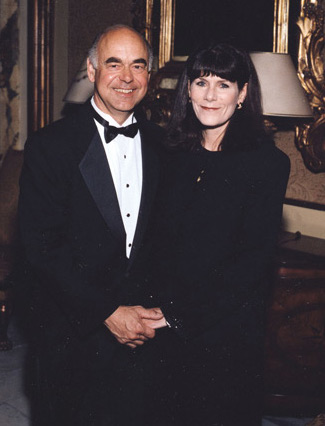 Throughout this period — first under the leadership of Dr. McArthur, and then under that of his former student Dr. Thomas E. Dillon a longtime tutor who became president in 1991 — both the College’s reputation and its financial support continued to grow. “At a time of great need,” says Dr. McArthur, “God sent the College many generous friends who made the completion of this campus possible.”
Throughout this period — first under the leadership of Dr. McArthur, and then under that of his former student Dr. Thomas E. Dillon a longtime tutor who became president in 1991 — both the College’s reputation and its financial support continued to grow. “At a time of great need,” says Dr. McArthur, “God sent the College many generous friends who made the completion of this campus possible.”
Three foundations, in particular, helped ensure the permanency of the College: The Dan Murphy Foundation, the DeRance Foundation, and the Fritz B. Burns Foundations. Their magnificent grants and many more generous gifts made possible the construction of four more permanent buildings, most notably St. Bernardine of Siena Library.
In 1996 President Dillon commenced efforts to design, fund, and build a permanent chapel to replace the small, temporary one in St. Joseph Commons. He envisioned a worthy House of God, one that would speak to the centrality of the Faith in the life of the College. Through his leadership and with a lead gift of $10 million from the Dan Murphy Foundation, on March 7, 2009, the College dedicated Our Lady of the Most Holy Trinity Chapel the crown jewel of the campus.
Shortly after allowing Dr. Dillon to see his dream fulfilled in the Chapel’s completion, however, God would call the president home. On April 15, 2009, Dr. Dillon died in a tragic automobile accident while traveling in Ireland for an academic conference. Fittingly, his would be the first funeral Mass ever to be offered in Our Lady of the Most Holy Trinity Chapel.
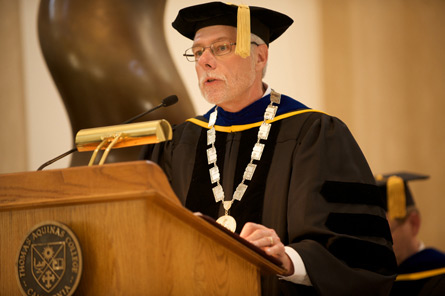 The Board of Governors promptly named Mr. DeLuca, one of the College’s founders and then its senior vice president for finance and administration, as interim president. Mr. DeLuca held that position until the Board appointed the College’s then-dean, Dr. Michael F. McLean, as his permanent successor in January, 2010. “We were blessed with a very smooth period of transition,” recalls Dr. McLean. “Shocking though the news of Dr. Dillon’s death was, the College remained focused on its mission, our benefactors remained loyal, and the good work our founders started nearly four decades ago continued.”
The Board of Governors promptly named Mr. DeLuca, one of the College’s founders and then its senior vice president for finance and administration, as interim president. Mr. DeLuca held that position until the Board appointed the College’s then-dean, Dr. Michael F. McLean, as his permanent successor in January, 2010. “We were blessed with a very smooth period of transition,” recalls Dr. McLean. “Shocking though the news of Dr. Dillon’s death was, the College remained focused on its mission, our benefactors remained loyal, and the good work our founders started nearly four decades ago continued.”
Two Founders Are Called Home
Not long after the fall semester began in 2010, founder and senior tutor Mark Berquist was diagnosed with lymphoma. After a brief illness, he passed away in the early hours of All Soul’s Day, November 2. One who had always avoided the spotlight in life, he was the subject of numerous accolades from his co-founders and colleagues at a reception following his funeral in the campus chapel. One after another, they described the character of this quiet man, the power of his intellect, and the pivotal role he had played in founding and sustaining the College.
Two years later, Dr. McArthur fell ill. He had returned to the College as a tutor in 2002, but now with a heavy heart he was forced to retire. In the early hours of October 17, 2013, he passed away peacefully at his home, succumbing to renal disease.
His passing marked the end of an era. By the sheer power of his convictions and personality, Dr. McArthur had attracted an impressive array of collaborators and brought the College to life. He had recruited faculty members and students, managed scarce funds, entertained guests, spoken at gatherings, courted benefactors, given lectures and talks, and taught hundreds of students in courses across the curriculum. Now he was at rest in the Lord, having seen the fruits of his labor in the lives of the College’s alumni and the many ways they were taking part in the Lord’s work to renew the face of the earth.
Completing the California Campus
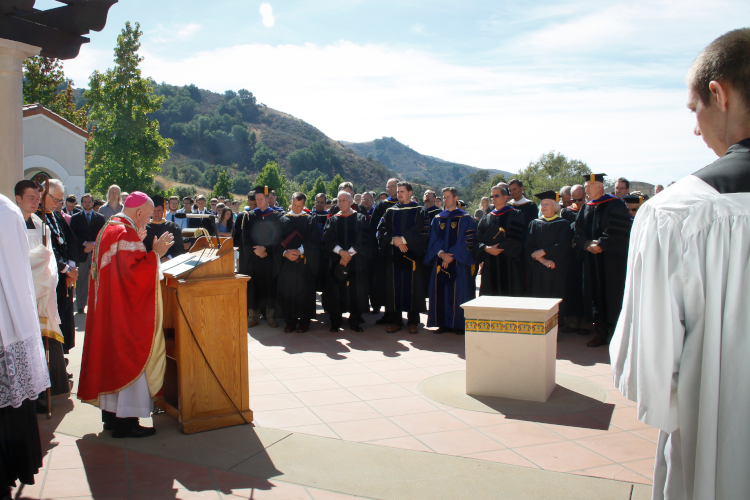
While much of the campus had been built out during Dr. Dillon’s tenure, there was still work to be done. With a generous grant from the Fritz B. Burns Foundation, St. Gladys Hall was erected on the academic quadrangle, housing much-needed space for daily classes. At the same time, upgrades were made to St. Augustine Hall across the quad. In use for nearly 30 years, it was in need of substantial work. Providing a grant for this project was the E. L. Wiegand Foundation.
Four years later, again with a large grant from the Fritz B. Burns Foundation, Archbishop Gomez dedicated a new lecture and concert hall to St. Cecilia, martyr and the patroness of music. It is now the venue for the St. Vincent de Paul Lecture and Concert Series
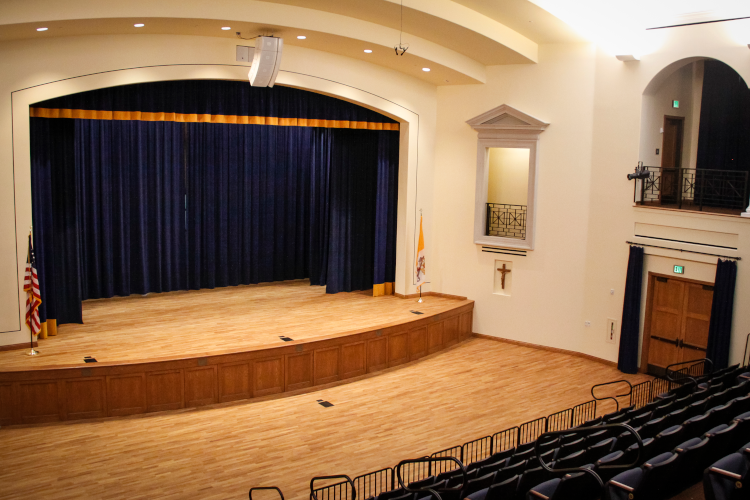
In 2018, over 700 acres of open space surrounding the California campus went on the market. The College had long hoped to procure this property not only to provide a buffer for the core campus but also to enhance student recreation. With the leadership and expertise of the vice chairman of the Board of Governors, Dieter Huckestein, and members Don Swartz and Bud Daily, College officials were able to conduct a smooth transition of ownership. The acquisition substantially reassembles the historic Ferndale Ranch, 131 acres of which were first deeded to the College in 1975.
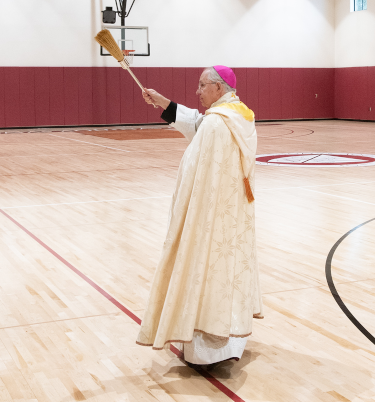
Some four years later, on October 22, 2022 — the Feast of Pope St. John Paul II — the Most Rev. José H. Gomez, Archbishop of Los Angeles, dedicated the final building on the California campus’s master plan: the 17,000-square-foot Pope St. John Paul II Athletic Center, also made possible by a substantial grant of the Fritz B. Burns Foundation. The Ahtletic Center features a gymnasium, climbing and bouldering walls within its clock tower, an outdoor swimming pool, lighted basketball and tennis courts, and men’s and women’s weight and workout rooms. “May God, Who brings light to our minds and strength to our bodies, guide us in all that we do,” the Archbishop prayed, “so that each day we may find gladness and friendship.”
Resisting a Government Mandate
In the year before Dr. McArthur’s death, there were rumors of a regulation to be issued under the Affordable Care Act by the U.S. Department of Health and Human Services that would require Catholic organizations and institutions to provide coverage for contraception, abortifacients, and other morally objectionable services to its employees. Depending on the details of the impending mandate, the College, according to its Catholic character, would not be able to comply with it.
On May 27, 2012, the HHS Mandate, as it came to be known, was issued. In August of 2013, the Obama Administration finalized the regulation and put in place crushing financial penalties for institutions that did not comply. There was no choice but for the College to begin legal proceedings which would eventually end at the U.S. Supreme Court. In 2017, in a great victory for the College and for religious liberty, a settlement agreement was reached with the U.S. government permanently exempting the College from the HHS Mandate.
Surviving an Inferno
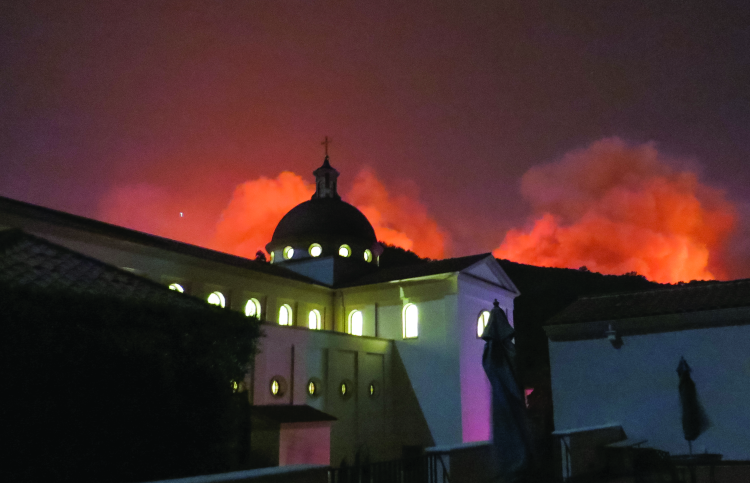
While the HHS mandate had been a threat to the College’s character as a Catholic institution, the Thomas Fire that broke out on the night of December 4, 2017, was a threat to its very existence. Named for the College because its point of ignition was just one quarter of mile south of the campus, its flames were fanned by the devilish Santa Ana winds that blow through Southern California in the fall each year.
Students were quickly evacuated from campus and housed at the homes of faculty, staff, and local families and board members. President and Mrs. McLean remained on campus with one of the chaplains and a few members of the facilities crew who worked with firefighters throughout the night. In the early hours of December 5, the campus was surrounded by fire, and it appeared likely that it would be lost. Against all odds, though, it survived. Through the firefighters’ heroic work, the flames amazingly — perhaps miraculously — never reached any of the buildings
Though the campus was saved, there was much to be done: While the buildings had been spared, the perimeter of the main campus and much of the lower campus by the Hacienda, had not. Over 100 fallen trees — some still smoldering — would have to be cleared, along with tons of scorched and burned brush. Fencing that had either burned or melted in the extreme heat would have to be removed and replaced. And interior spaces would require heavy cleaning and air purification.
Many among the College’s benefactors stepped up with generous gifts and grants for this effort, and when students returned from the Christmas holidays, the school was well on the road to recovery.
Eastward Bound!
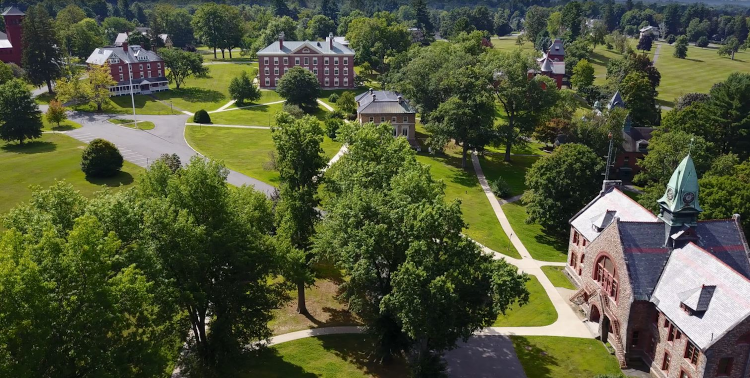
With the College having reached its maximum enrollment in 2005, waiting lists were growing longer each year. There had been some discussion of opening a second campus during Dr. Dillon’s presidency, but it was thought then that the College should finish building its first campus before taking on another. In 2014, as campus construction neared an end, the question of expansion arose again, and with it a tremendous opportunity.
The College learned of a property available in Western Massachusetts. Established in the late 19th century by evangelist and Biblical scholar Dwight L. Moody, the Northfield property had a history of education and evangelism. It originally was part of the Northfield Mount Hermon School, which began as two institutions — Northfield Seminary for Young Ladies in 1879 and Mount Hermon School for Boys in 1881. The two schools became a single institution in 1971 and consolidated to the Mount Hermon campus in 2005, leaving the Northfield campus vacant. Located in a lovely rural setting in the Connecticut River Valley, approximately 90 miles northwest of Boston, the 217-acre property was a beautiful and gracious site, with impressive buildings, many more than 100 years old.
The Green family of Hobby Lobby fame purchased the Northfield campus in 2009. After performing some deferred maintenance, they donated it to the National Christian Foundation (NCF) to conduct a search for a suitable entity to which the property would be given. The hope was to deed it to an organization that would in some way continue the Moody tradition of faith and learning.
In consultation with the Board of Governors and the faculty, senior TAC officials began the application process with the NCF. When the NCF awarded the property to another organization, it appeared that there would be no second campus for the College, at least for the time being.
Not long after, however, representative of the NCF contacted the College to say that plans had fallen through, and would Thomas Aquinas College be interested in re-applying for the Northfield property? Second chances like this don’t come along often, and College officials welcomed the opportunity.
With the school’s second application under consideration, Dr. McLean invited the NCF Board member Emmitt Mitchell to visit the California campus to see the College as it lives. While there, he met with senior staff, board members, tutors, and students, and later commented, “I was impressed. There are just no weak links in Thomas Aquinas College, even up to and through the Board of Governors.” There was also a growing appreciation among all parties of the resonance between the College’s mission and Dwight Moody’s legacy. It seemed the Holy Spirit was at work.
On February 7, 2017, the NCF informed Dr. McLean that of the 153 applications it had received, Thomas Aquinas College’s had been accepted. The NCF would transfer ownership of the Northfield property to the College and establish a $5 million matching-grant fund to help the school launch its unique program of Catholic liberal education in New England.
The plan for the new campus was to start small and build slowly, just as the founders had done in California. Seasoned tutors from the California campus would move east as part of this new venture and serve as a strong source of congruence between the California and New England campuses in all aspects: the academic program, the residential life, and the spiritual life of the new community.
Approval from the Commonwealth of Massachusetts was obtained in the fall of 2018, and the College’s accreditor, WSCUC, extended its existing accreditation to the New England campus a few months later.
Thomas Aquinas College would now be one college on two campuses, with one faculty, one curriculum, one Board of Governors, and one founding and governing document, A Proposal for the Fulfillment of Catholic Liberal Education.
The Most Rev. Mitchell T. Rozanski, Bishop of Springfield, Massachusetts, presided over the first Convocation Day on the New England campus on Saturday, August 24, 2019, offering a Mass of the Holy Spirit and, at the matriculation ceremony that followed, administering the Oath of Fidelity and Profession of Faith to all of the faculty. The new students then came forward to sign the College’s register, and Dr. McLean welcomed them all to the College, expressing great confidence in the leadership of Dean Tom Kaiser.
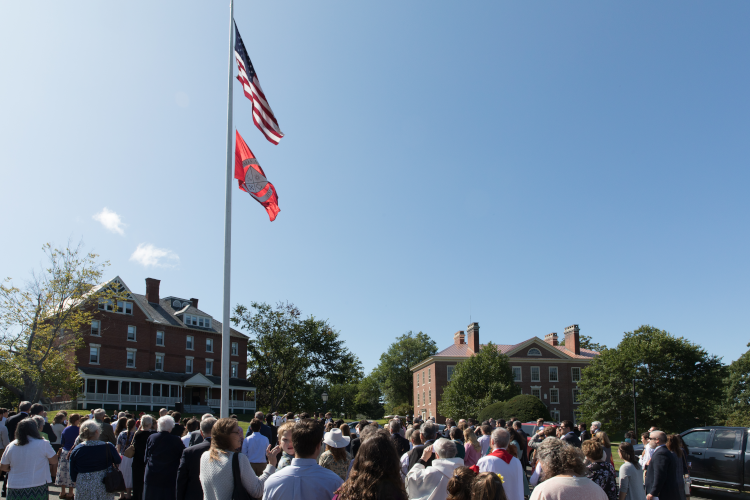
Learning in a Time of Pandemic
Having led the College to a legal victory against the HHS mandate, survived the Thomas Fire, and helped further the College’s work significantly in the opening of a second campus, Dr. McLean may have hoped the next few years would be uneventful. This was not to be the case. In the winter of 2020, the novel coronavirus began to sweep across the United States. As businesses and organizations shut down to stem the spread of infection, the College, too, would have to close its campus and transition to online classes.
Students on both campuses had to be sent home, and TAC staff worked around the clock to set up a system of virtual classrooms for the College’s signature discussion-based seminars. Within a week, tutors and students were meeting online and would do so for the rest of the spring semester, with a modified class schedule to accommodate students’ time zones.
Determined to open for in-person classes for the fall semester, President McLean, Dean John Goyette, and other senior staff worked closely with local health officials and a medical advisory board to produce a plan that would keep students, faculty, and staff safe. It was approved for use during the summer High School Summer Great Books programs held on both campuses, and modified for the regular academic year.
Students returned to campus in August of 2020, overjoyed to be with their friends and classmates again and committed to abiding by the restrictions necessary to keep the College open. Classes were held outside for most of the semester, as was Mass. Dean Goyette continued to navigate the ever-changing COVID landscape, and students cooperated beautifully with all of his directives and recommendations. At the end of the first semester, the Dean received a touching note of gratitude addressed to all of the College’s employees from the students, thanking them for all they done to make it possible for them to live on campus over the past months and pursue their education in person.
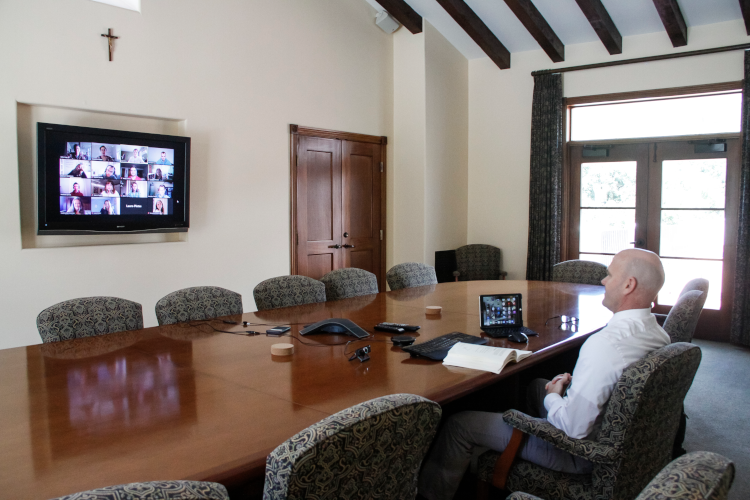
The College Celebrates its Golden Anniversary
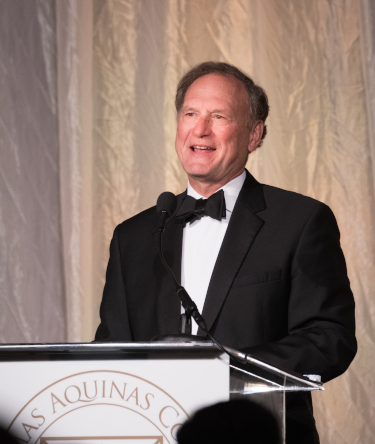
With the approach of the College’s golden anniversary in 2021, the California campus was nearing completion and the East Coast campus was bustling with its first students and undergoing much-needed renovations. It appeared that, after five decades, the College was just hitting its prime.
To celebrate this achievement, President McLean proclaimed a year of festivities. “We know that God has been at work in the life of the College because the extraordinary successes of these 50 years could never have been achieved through merely human effort,” he said. “This glorious gift of Divine Providence must be celebrated properly — which is to say, extensively.”
Those extensive celebrations included regional events hosted by the College’s several Boards of Regents across the country, but the crowning event was the 50th Anniversary Gala, hosted on October 21, 2021, at the historic Beverly Wilshire Hotel in Los Angeles, California, and featuring a keynote address by United States Supreme Court Justice Samuel Alito, who the following year would draft Dobbs v. Jackson, the landmark Supreme Court decision overturning Roe v. Wade.
More than 600 friends of the College — including members of the Board of Governors, alumni, students, faculty, staff, and visiting clergy and religious — attended the event, where guests joyfully shared memories of the last 50 years. In his warm and thoughtful keynote, Justice Alito recalled the cultural turmoil of the late 1960s and early 1970s, when academia was voluntarily jettisoning reasoned discourse and the Western intellectual tradition. “The story of the founding of Thomas Aquinas College is a remarkable one,” said Justice Alito. “What the founders of the College were professing constituted the real counterculture.”
“For 50 years Thomas Aquinas College has been on a quest for truth,” Justice Alito continued. “May it continue that quest for 50 more years, and 50 years after that, and 50 years after that, and many more years to come. Happy anniversary, Thomas Aquinas College!”
A Second Campus … and a Fifth President
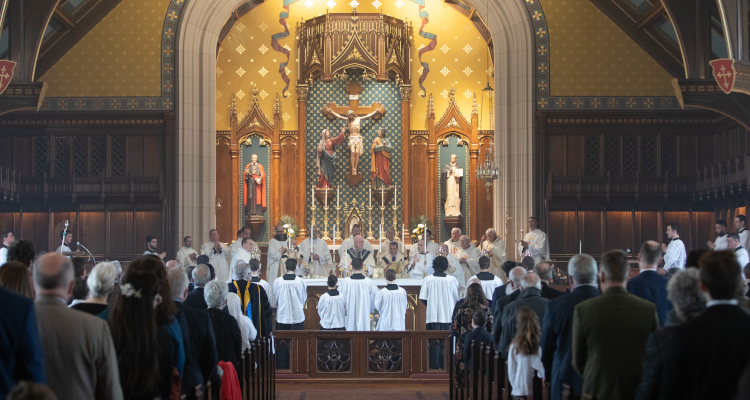
Soon after the 50th Anniversary Gala, the New England campus passed two more milestones: the dedication of Our Mother of Perpetual Help Chapel and the graduation of its first Senior Class.
Renovations to Northfield’s Sage Chapel began not long after the College took ownership of the property in 2019, but more than mere upgrades were in order. The formerly nondenominational chapel had to be properly outfitted for Catholic worship, requiring the addition of a central aisle, confessionals, and Stations of the Cross, as well as two altars, a tabernacle, and a reredos in the sanctuary.
With these transformations at last completed, the Most Rev. William D. Byrne, Bishop of Springfield, Massachusetts, came to Northfield to dedicate the renamed Our Mother of Perpetual Help Chapel on March 7, 2022, the Feast of St. Thomas Aquinas. As part of the Rite of Dedication, the Bishop placed relics of two beloved saints — St. John Henry Newman and St. Thomas himself — into the Chapel’s altars. These relics testify to the New England campus’s essential continuity with the spirit and mission of the College as outlined by its Founders in 1969.
Yet as Bishop Byrne observed, the dedication of the Chapel was a milestone for more than just Thomas Aquinas College. After decades of waning liturgical attendance in the Northeast, “the dedication of Our Mother of Perpetual Help Chapel blooms like the first flower of spring,” His Excellency said. “Winter makes way to summer. Days lengthen, and life prevails.”
Just two months later, on May 21, 2022, Thomas Aquinas College, New England, graduated its first Senior Class, marking the first time that the College hosted Commencements on both coasts. The Commencement Speaker, the Most Rev. Robert J. McManus, Bishop of Worcester, Massachusetts, saw seeds of hope in the 32 first graduates of TAC-New England. Recalling the example of St. Benedict, whose flight from the world made possible the medieval flowering of Christian culture, he exhorted the Class of 2022 to imitate the saint: “You have received an excellent classical Catholic education here at Thomas Aquinas College that has prepared you to be the new ‘Benedicts’ of our contemporary American culture.”
At the conclusion of Commencement ceremony, there were two other historic “firsts” on the Northfield, Massachusetts, campus: Dr. Paul J. O’Reilly (’84) took the presidential Oath of Office, becoming the College’s first alumnus to assume the presidency, and the first president to take office in New England. “Paul O’Reilly was deeply invested in helping to establish and develop our New England campus from the very beginning,” said outgoing President Michael F. McLean, who was stepping down to return to the classroom. “It is only fitting that he would take the Oath of Office here in Northfield.”
“It was six years ago when I first came to this campus, in the hopes that it may one day become the East Coast home of Thomas Aquinas College,” remarked the new president. “To be here now for our first New England Commencement, and to take the presidential Oath of Office, is humbling and gratifying. Thanks be to God for the blessings He has bestowed upon the College, as well as to Dr. McLean for his 12 years of tremendous leadership.”
A few months later, Dr. O’Reilly would take the Oath of Office once more at a formal Inauguration ceremony on the California campus, held on October 22 — the feast of St. John Pall II and the dedication of the newly completed Athletic Center named in the beloved saint’s honor.
In his homily at that morning’s Mass in Our Lady of the Most Holy Trinity Chapel, the Most Rev. José H. Gomez, Archbishop of Los Angeles, reminded the College of its ecclesial vocation. “The Lord entrusts you with this sacred responsibility: To feed and tend these young hearts and minds, to give them knowledge of the truth,” His Excellency said. “Only in this wisdom, only in Jesus Christ, can we flourish in this world and know the love that never ends.”
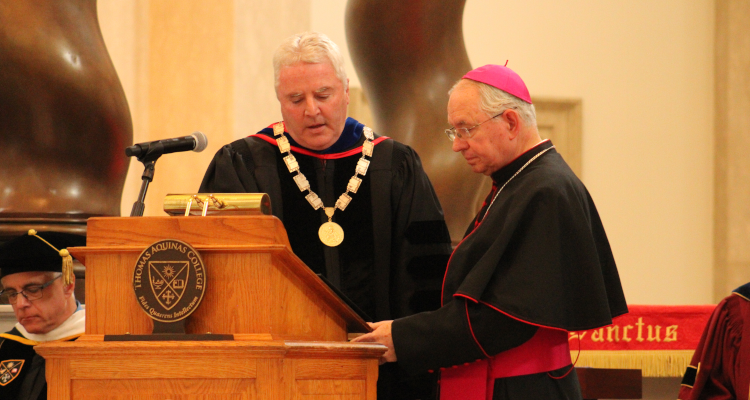
More Farewells From the Founding Generation
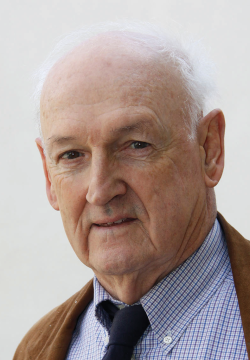
Even during this exciting and joyful time, however, the College was not immune to sorrow. On July 4, 2022, one of its founders, Dr. John “Jack” W. Neumayr passed away not long after celebrating Independence Day with his family. Fittingly, he was laid to nearby his friends and co-founders, Dr. Ronald P. McArthur and Marcus A. Berquist, at Pierce Brothers Cemetery in Santa Paula, California.
A few months later, friends and family came to the California campus to mourn the passing of Marilyn McArthur, who was, in the words of President Paul J. O’Reilly, “the First Lady of Thomas Aquinas College.” The wife of the College’s late founding president, Dr. Ronald P. McArthur, she was, Dr. O’Reilly continued, “a devoted, faithful wife to Ron through all the phases of his life and the beloved matriarch of this community.”
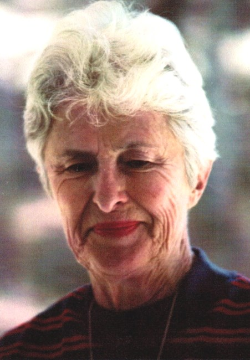
Mrs. McArthur was also buried in Santa Paula’s cemetery, prompting the following observation from the College’s director of special projects, Anne (Schaeffer ’81) Forsyth: “When that last trumpet sounds, what a celebration there will be at our little cemetery in Santa Paula, where friends and collaborators, who brought the College to life and sustained it, will find each other again and together enter into the heavenly Jerusalem.”










